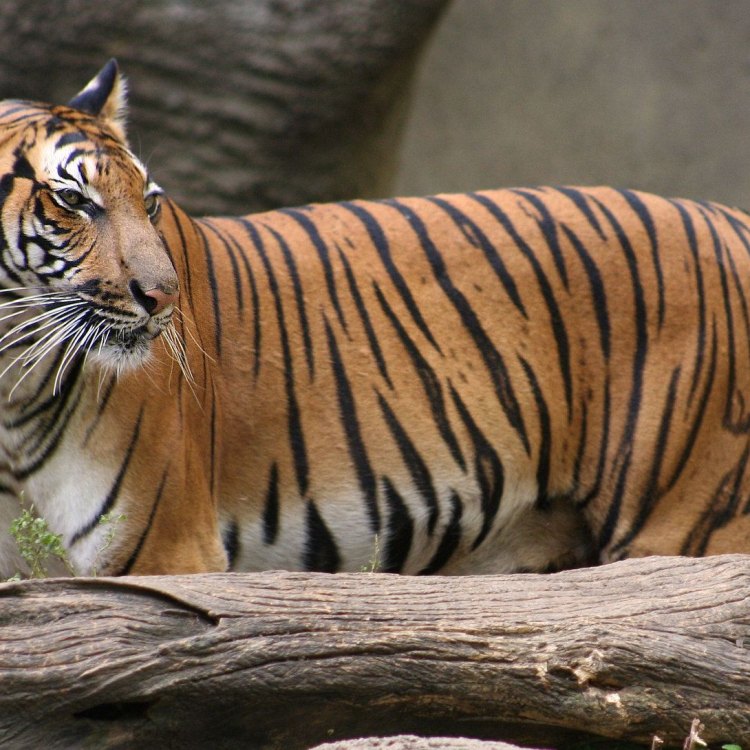
Malayan Tiger
Up to 3 meters (including the tail)
The Malayan Tiger, a majestic and powerful creature, can grow up to 3 meters in length, including its tail. This magnificent animal belongs to the Felidae family and is found in the southern and central areas of Malaysia. Its large and muscular body shape makes it one of the most feared predators in its habitat. #MalayanTiger #Malaysia #Felidae
Animal Details Summary:
Common Name: Malayan Tiger
Kingdom: Animalia
Habitat: Tropical Rainforests and Deciduous Forests
Unleashing the Beauty and Power of the Majestic Malayan Tiger
The dense, lush forests of Malaysia hide within their depths a majestic and powerful creature – the Malayan Tiger. This stunning big cat, with its golden-orange coat and dark stripes, is one of the most iconic species of Malaysia, captivating the hearts of both locals and tourists alike. It is a symbol of strength, grace, and beauty, but most importantly, it represents the rich biodiversity of the country.A Tiger of Many Names
The Malayan Tiger is also known as the Panthera tigris jacksoni, named after Peter Jackson, an eminent tiger conservationist Malayan Tiger. Its common name, Malayan Tiger, comes from its native home, Malaysia. It falls under the Animalia kingdom and belongs to the Chordata phylum, which includes animals with a spinal cord. As a member of the Mammalia class, the Malayan Tiger is a warm-blooded animal that gives birth to live young and feeds them with milk. Within the Carnivora order, it belongs to the Felidae family, which includes other large cats like lions, jaguars, and leopards.A Habitat Fit for A King
The Malayan Tiger is a habitat specialist, thriving in tropical rainforests and deciduous forests. These habitats provide adequate food, water, and shelter for the tiger to live and hunt. The forests also have an abundance of prey, such as deer, boars, and wild cattle, to sustain its carnivorous diet. Unfortunately, due to deforestation and human activities, the tiger's habitat is shrinking, leaving them vulnerable and endangered.A Carnivorous Predatory Machine
As a top predator, the Malayan Tiger is essential in regulating the ecosystem by keeping the population of its prey in check Milkweed Aphids. It is a solitary animal, and only comes together with other tigers during mating season. Its diet consists of mostly large mammals, and it is a highly adaptable hunter, able to stalk and ambush its prey with precision and agility.A Stunning Geographical Distribution
The Malayan Tiger is native to Malaysia, but its distribution is limited to the southern and central parts of the country. It is only found in the Royal Belum State Park, Taman Negara National Park, and the Endau-Rompin National Park. These protected areas have the perfect mix of dense forests, prey availability, and minimal human presence, making it an ideal location for the Malayan Tiger to thrive.Conservation Efforts for the Malayan Tiger
The Malayan Tiger is facing numerous threats, and its population has dwindled to just over 200 individuals. Habitat loss, poaching, and human-wildlife conflict are the main contributors to this alarming decline. To protect and preserve this majestic animal, various conservation efforts are underway in Malaysia.The Department of Wildlife and National Parks (PERHILITAN) of Malaysia is actively working towards protecting the Malayan Tiger and its habitat. It conducts patrols, research, and monitoring activities to safeguard the tiger from poachers. PERHILITAN also collaborates with NGOs, local communities, and other government agencies to raise awareness and educate the public on the importance of conservation.
The Role of Technology in Protecting the Malayan Tiger
Apart from traditional conservation efforts, technology has also played a crucial role in protecting the Malayan Tiger. One such tool is the use of camera traps, which have helped researchers and conservationists learn more about the behavior and population of the tiger. These camera traps capture images and videos of wild tigers without human intervention, providing valuable insights and data for future conservation efforts.Another innovative technology being used is the implementation of GIS (Geographic Information System) mapping, which allows researchers and conservationists to monitor and track the tiger's movements and habitat changes in real-time. The data collected through this technology can aid in developing effective conservation strategies, ensuring the protection of the Malayan Tiger.
Responsible Tourism for the Malayan Tiger
As responsible citizens, we should be aware of our impact on the environment and the wildlife around us. Despite the declining numbers of the Malayan Tiger, it is still possible to observe and appreciate this magnificent animal through responsible tourism. By choosing tour agencies that follow sustainable practices and promote conservation efforts, visitors can contribute to the protection and preservation of the Malayan Tiger.Some tour agencies offer guided trekking tours in protected areas, providing a glimpse into the natural habitat of the Malayan Tiger without disrupting their natural behavior. These tours also educate tourists on the importance of conservation and how they can contribute to protecting these animals.
The Future of the Malayan Tiger
Through government efforts, advanced technology, and responsible tourism, there is still hope for the Malayan Tiger's survival. The government of Malaysia has set a target to double the population of the Malayan Tiger by 2022, and there is a growing public awareness and support for tiger conservation. However, the responsibility of protecting this endangered species falls upon all of us. As individuals, we must educate ourselves and others, make responsible choices, and support conservation efforts to ensure the survival of the Malayan Tiger.The Malayan Tiger is more than just a beautiful animal; it is a crucial part of Malaysia's cultural and ecological heritage. As Charles Darwin said, "In the long history of humankind (and animal kind, too) those who learned to collaborate and improvise most effectively have prevailed". It is time for all of us to collaborate and improvise to protect and preserve the Malayan Tiger, ensuring its rightful place in Malaysia's rich biodiversity for generations to come.

Malayan Tiger
Animal Details Malayan Tiger - Scientific Name: Panthera tigris jacksoni
- Category: Animals M
- Scientific Name: Panthera tigris jacksoni
- Common Name: Malayan Tiger
- Kingdom: Animalia
- Phylum: Chordata
- Class: Mammalia
- Order: Carnivora
- Family: Felidae
- Habitat: Tropical Rainforests and Deciduous Forests
- Feeding Method: Carnivorous
- Geographical Distribution: Malaysia
- Country of Origin: Malaysia
- Location: Southern and Central Malaysia
- Animal Coloration: Golden-orange coat with dark stripes
- Body Shape: Large and muscular
- Length: Up to 3 meters (including the tail)

Malayan Tiger
- Adult Size: 180-260 cm (head to body)
- Average Lifespan: 10-12 years
- Reproduction: Sexual
- Reproductive Behavior: Polygamous
- Sound or Call: Roaring
- Migration Pattern: Sedentary
- Social Groups: Solitary
- Behavior: Territorial and stealthy hunters
- Threats: Habitat loss, poaching, and illegal wildlife trade
- Conservation Status: Critically Endangered
- Impact on Ecosystem: Top predator, helps maintain balance in the ecosystem
- Human Use: Poaching for body parts and illegal trade
- Distinctive Features: Prominent facial stripes and white spots on the back of the ears
- Interesting Facts: The Malayan Tiger is the only surviving subspecies of the Indochinese tiger in the Malay Peninsula.
- Predator: No natural predators

Panthera tigris jacksoni
The Mighty Malayan Tiger: A Majestic and Endangered Predator
The Malayan Tiger, also known as the Panthera tigris jacksoni, is a magnificent and critically endangered cat species native to the Malay Peninsula. Recognized as a national symbol of Malaysia, the Malayan Tiger is a powerful and majestic predator that plays a crucial role in maintaining the ecological balance of its habitat. Despite its iconic status, this large feline is facing an uncertain future due to various threats, including habitat loss, poaching, and illegal wildlife trade.In this article, we will take a deep dive into the world of the Malayan Tiger, exploring its unique features, behavior, impact on the ecosystem, and the challenges it faces for survival PeaceOfAnimals.Com.
The Physical Characteristics of the Malayan Tiger
The Malayan Tiger is a subspecies of the Indochinese tiger, distinct from other subspecies such as the Bengal and Sumatran tigers. As the smallest of the mainland tiger subspecies, it is still an imposing creature, with adult males measuring 180-260 cm from head to body, and weighing between 120-140 kg. Female Malayan Tigers, on the other hand, are smaller, measuring around 170-230 cm and weighing between 90-110 kg.One of the most distinctive features of the Malayan Tiger is its fur, which ranges from a vibrant orange to a deep reddish-brown, with black stripes and a white belly. Its fur does not come in one solid shade, but rather in a unique pattern of stripes, making each tiger easily identifiable. These stripes also provide camouflage while hunting, allowing the Malayan Tiger to blend seamlessly into its surroundings.
Another standout characteristic of the Malayan Tiger is its large, powerful paws with retractable claws. These claws, which can reach up to 10 cm in length, are essential for hunting and securing prey. The unique structure of their paws also enables them to silently stalk their prey, making them stealthy predators Mouse Deer.
One of the most striking features of the Malayan Tiger is its face, adorned with prominent white stripes that extend from its eyes to its jaw. These facial stripes are unique to each tiger, like a human fingerprint, and play a crucial role in identifying individuals. Another distinct characteristic of the Malayan Tiger is the white spots on the back of its ears, which act as a visual communication signal to other tigers.
Behavior and Reproduction
The Malayan Tiger is a solitary and territorial animal, with each individual marking its territory and defending it fiercely from other tigers. Their territories can span up to 100 square kilometers, depending on the availability of resources. These large cats are also stealthy hunters, using their camouflage and agility to their advantage when stalking prey.When it comes to reproduction, the Malayan Tiger follows a polygamous mating behavior, with males mating with multiple females. Breeding usually occurs throughout the year, but peak mating season typically falls between November and April. After a gestation period of around 3-4 months, females give birth to a litter of 2-4 cubs. These cubs will stay with their mother for about 2-3 years, learning essential survival skills before venturing off on their own.
Role in the Ecosystem
As an apex predator, the Malayan Tiger plays a crucial role in maintaining the balance of its ecosystem. Its diet consists mainly of large herbivores, such as deer and wild boar, helping to control their populations. This, in turn, prevents overgrazing and allows for healthy plant growth, benefiting the entire ecosystem.The Malayan Tiger also helps control the number of smaller predators, such as wild cats and foxes, preventing them from overeating and disrupting the ecosystem's balance. Without this apex predator, the ecosystem would suffer, leading to a cascade effect that could have severe consequences for other species.
Disturbances and Threats
Sadly, despite its vital role in the ecosystem, the Malayan Tiger is facing numerous threats that put its very existence in jeopardy. The primary cause of their declining population is the loss of habitat due to deforestation and human development. This reduces the tiger's hunting grounds and forces them into close proximity with humans, increasing conflict and endangering both humans and tigers.Poaching and illegal wildlife trade are also significant threats to the Malayan Tiger. The demand for tiger body parts, used in traditional medicine and as luxury items, drives the illegal trading market, with tigers being brutally killed for their skin, bones, and claws. It is estimated that there are only around 200-250 Malayan Tigers left in the wild, with this number continuing to decrease due to these threats.
Conservation Efforts
Recognizing the urgency to protect this critically endangered species, various organizations and governments are taking action to conserve the Malayan Tiger. The Malaysian government has implemented laws and policies to protect the species and their habitat, including increasing patrols and enforcing stricter penalties for poaching.Conservation organizations and NGOs have also been working tirelessly to raise awareness, conduct research, and establish protected areas for the tigers. These efforts have shown some positive results, with a slight increase in the Malayan Tiger population in recent years. However, more significant efforts and support are needed to secure a sustainable future for these majestic creatures.
Implications for Humans
The Malayan Tiger is not only an essential part of the ecosystem, but it also holds cultural and symbolic significance for the people of Malaysia. The tiger has been featured in the country's coat of arms and is celebrated in art and literature. It is considered a national treasure and an integral part of Malaysia's heritage.However, the Malayan Tiger's decline has created a negative impact on the country's economy, as it is a major tourist attraction. With fewer tigers, there are fewer sightings, leading to decreased tourism revenue. This, in turn, affects the livelihoods of local communities, who rely on tourism for their income.
Final Thoughts
The Malayan Tiger, with its prominent stripes, powerful paws, and importance in the ecosystem, is a magnificent and unique creature that deserves our attention and protection. As the only surviving subspecies of the Indochinese tiger in the Malay Peninsula, its existence is crucial not only for its survival but also for the balance of its habitat and the well-being of humans.We cannot afford to lose such a remarkable and iconic species to the threats of habitat loss, poaching, and illegal trade. It is up to all of us to take action and support conservation efforts to ensure that future generations will continue to witness the majestic presence of the Malayan Tiger in their natural habitat. Let us unite to save this endangered predator and help it roar with strength and dominance once again.

Unleashing the Beauty and Power of the Majestic Malayan Tiger
Disclaimer: The content provided is for informational purposes only. We cannot guarantee the accuracy of the information on this page 100%. All information provided here may change without prior notice.












